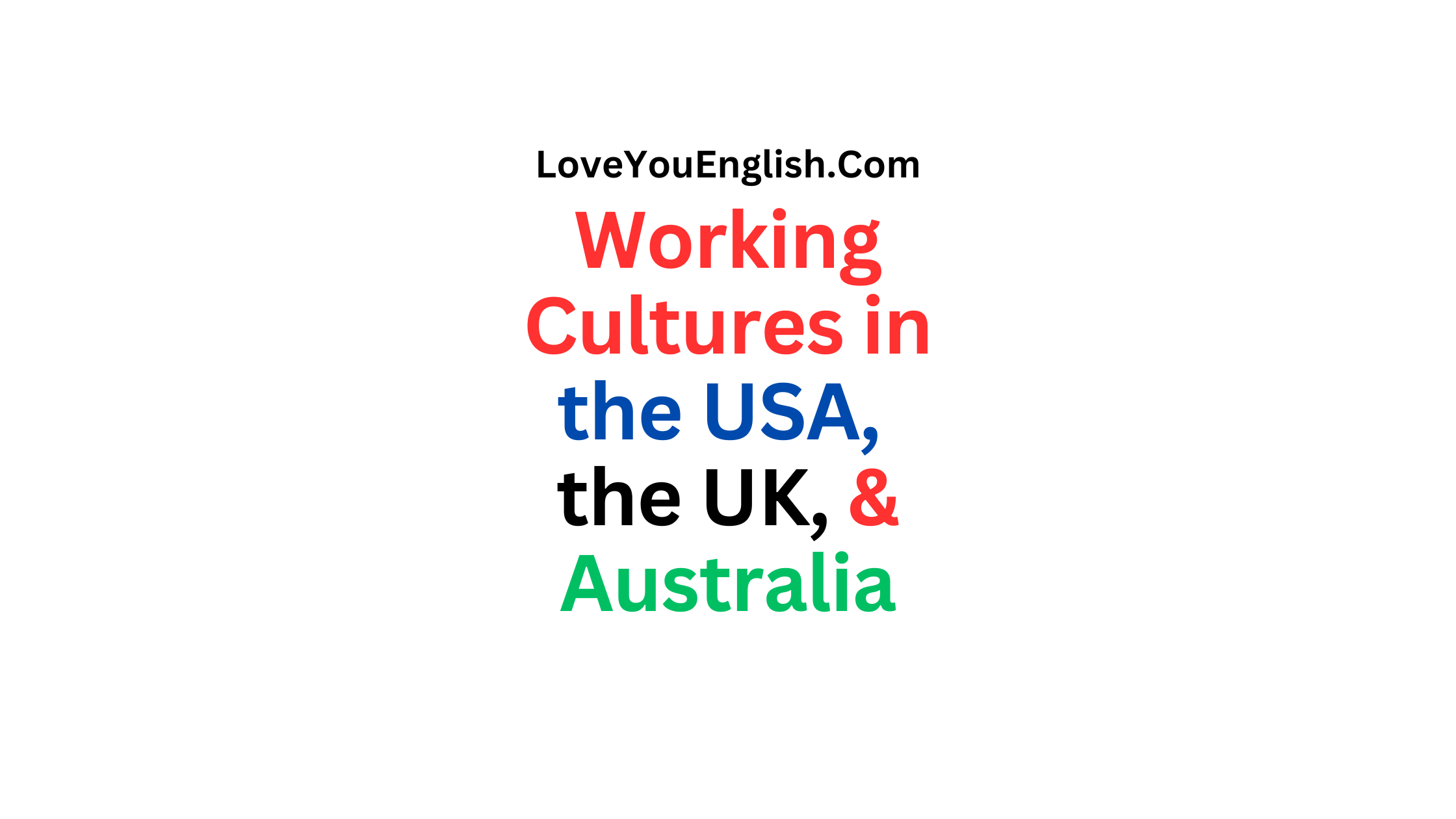Working Cultures in the USA, United Kingdom, and Australia
Working Cultures in the USA, United Kingdom, and Australia
The work cultures in the USA, UK, and Australia are alike in many ways because they are all English-speaking, developed Western countries.
But there are also some big differences in how people work, communicate, and balance work and personal life in these three places.
This blog will look at and compare different parts of work culture in the USA, UK, and Australia to show what they have in common and what makes them unique.
Work Ethic and Hours
United States:
The US is known for having a particularly strong work ethic and long working hours compared to many other developed nations.
The average American works about 1,767 hours per year according to OECD data.
There is a cultural emphasis on hard work, ambition, and “hustle” that permeates many industries and workplaces.
Long hours are common in many professional fields, with 50-60 hour work weeks not unusual in sectors like finance, law, and technology.
Americans take relatively few vacation days compared to their counterparts in other wealthy nations – an average of 10 paid vacation days per year.
United Kingdom:
The UK has a strong work ethic but tends to place more value on work-life balance than the US.
British workers log an average of 1,538 hours per year – significantly less than Americans.
The standard work week is around 37-40 hours, though longer hours are common in certain industries like finance.
UK workers are legally entitled to 28 days of paid leave per year (including public holidays), which most take advantage of.
There’s generally less of a “live to work” mentality compared to the US.
Australia:
Australia falls somewhere between the US and UK in terms of working hours, with Australians working an average of 1,665 hours annually.
The standard work week is 38 hours, though many full-time workers put in more than that.
Australians are known for valuing work-life balance, with a strong emphasis on leisure time and outdoor activities.
Workers typically receive 4 weeks of paid annual leave plus about 10 public holidays.
Many Australians take advantage of this generous leave to go on extended holidays.
You may want to read:
- Common Job Interview Questions and How to Answer Them
- Can English Help You Get That Promotion at Work?
- 10 Common Interview Questions and Answers in English
- 6 Ways to Build Confidence at Work
- How to Prepare for a Job Interview in English
Workplace Hierarchies and Management Styles
United States:
American workplaces tend to have more defined hierarchies than those in the UK or Australia.
There’s often a clear chain of command, and it’s generally expected that decisions will flow from the top down.
Employees may be less likely to openly disagree with or challenge superiors.
That said, there has been a trend in recent years, especially in industries like tech, towards flatter organizational structures and more collaborative decision-making processes.
Still, respect for authority and clear leadership remain important in most US workplaces.
United Kingdom:
British workplaces often have less rigid hierarchies than those in the US.
While there are still clear management structures, there tends to be more emphasis on consensus-building and getting input from various levels of the organization.
British workers may be more comfortable disagreeing with superiors or offering alternative viewpoints, though this is typically done in a polite and understated manner.
Managers are expected to listen to and consider employee input, even if they ultimately make the final decisions.
Australia:
Australian work culture is known for being relatively egalitarian and informal.
There’s often less emphasis on titles and formal hierarchies compared to both the US and UK.
This is reflected in the concept of “mateship” – a cultural idea of equality and mutual respect regardless of social status.
Managers in Australia are generally expected to be approachable and to foster a collaborative environment.
Employees may feel more comfortable speaking up or challenging ideas regardless of their position in the company.
However, this informality doesn’t mean a lack of respect or professionalism.
Communication Styles
United States:
American workplace communication tends to be direct and explicit.
There’s an emphasis on clear, unambiguous language and getting straight to the point.
Americans often prefer to address issues or conflicts head-on rather than avoiding confrontation.
Positive reinforcement and enthusiasm are common in US workplaces.
Managers often provide frequent feedback and encouragement.
However, this can sometimes come across as insincere or over-the-top to workers from other cultures.
United Kingdom:
British communication in the workplace is often more understated and indirect compared to American styles.
There’s a greater tendency to use qualifiers, hedging language, and polite phrasing even when giving criticism or instructions.
Humor, particularly dry wit and self-deprecation, plays a larger role in British workplace communication.
Sarcasm and gentle teasing can be ways of building rapport, though this can sometimes be misinterpreted by those from other cultures.
Australia:
Australian communication styles blend elements of both American directness and British understatement.
Australians tend to be fairly straightforward in their communication but may use more humor and informal language in the workplace compared to Americans or Brits.
There’s a cultural aversion to boasting or self-promotion in Australia, known as “tall poppy syndrome.”
This can manifest in the workplace as a preference for modesty and team achievements over individual accomplishments.
Work-Life Balance and Benefits
United States:
Work-life balance in the US is often viewed as more of an individual responsibility rather than something enforced by law or company policy.
There are no federal laws mandating paid vacation time, paid parental leave, or maximum working hours for most employees.
Benefits packages can vary widely between companies, with health insurance being a particularly important component due to the lack of universal healthcare.
Some companies, particularly in competitive industries, offer generous perks like unlimited vacation time, onsite gyms, or free meals to attract talent.
United Kingdom:
The UK has stricter labor laws that help enforce work-life balance.
This includes mandated paid vacation time, limits on working hours, and paid parental leave.
Many companies offer flexible working arrangements, including the ability to work from home part-time.
The National Health Service (NHS) provides universal healthcare, so company health insurance is less of a focus in benefits packages compared to the US.
Pensions and additional vacation time are often seen as valuable perks.
Australia:
Australia has strong protections for work-life balance enshrined in law.
This includes four weeks of paid annual leave, paid parental leave, and strict limits on working hours.
Many companies offer flexible working arrangements and additional leave options like purchased leave or career breaks.
Like the UK, Australia has a public healthcare system, so private health insurance is an additional rather than essential benefit.
Superannuation (retirement savings) contributions from employers are mandatory and an important part of compensation packages.
Diversity and Inclusion
United States:
Diversity and inclusion have become major focus areas for many US companies in recent years.
There’s increasing awareness of the importance of creating diverse workforces and inclusive environments.
Many large companies have dedicated D&I teams and initiatives.
However, progress is uneven, and issues of discrimination and lack of representation, particularly at higher levels of organizations, remain challenges in many industries.
The US workplace can be quite litigious, with legal protections against discrimination being an important aspect of workplace culture.
United Kingdom:
The UK has a strong focus on diversity and inclusion in the workplace, with legal protections against discrimination similar to those in the US.
Many companies have diversity initiatives and there’s growing awareness of issues like unconscious bias.
The UK’s colonial history and status as a multicultural society influence discussions around diversity, with a particular focus on racial and ethnic inclusion as well as gender equality.
Australia:
Australia has been making strides in workplace diversity and inclusion, though it’s generally seen as lagging somewhat behind the US and UK in this area.
There’s increasing focus on indigenous inclusion, gender equality, and creating more diverse leadership teams.
The concept of a “fair go” – giving everyone an equal opportunity – is a cultural value that influences diversity efforts in Australian workplaces.
However, challenges remain, particularly in terms of representation in leadership roles.
Professional Development and Career Progression
United States:
Career advancement in the US is often viewed as an individual responsibility.
There’s a cultural emphasis on self-promotion and “climbing the ladder.”
Changing jobs relatively frequently (every 2-3 years) is common and often seen as a way to advance one’s career and increase earning potential.
Many US companies offer professional development opportunities, but employees are generally expected to be proactive about seeking out these opportunities and advocating for promotions or raises.
United Kingdom:
Career progression in the UK tends to be more structured and gradual compared to the US. Loyalty to a company is often more valued, and internal promotions are common.
However, this is changing somewhat with younger generations being more open to job-hopping.
Professional qualifications and continuing education are highly valued in many industries.
Many companies have structured training programs and clear career paths for employees.
Australia:
Career progression in Australia often involves a mix of the US and UK approaches.
There’s value placed on loyalty and steady advancement within a company, but also recognition of the benefits of diverse experiences gained from changing jobs.
There’s a strong emphasis on work experience and practical skills in many industries.
Apprenticeships and vocational training play a significant role in professional development, particularly in trades and technical fields.
Dress Codes and Office Environments
United States:
Dress codes in US workplaces vary widely by industry and region.
Traditional corporate environments often still expect formal business attire, while many tech companies and startups have very casual dress codes.
Open plan offices are common, though there’s been some pushback against this in recent years.
Many companies try to create engaging office environments with perks like game rooms or relaxation areas, particularly in competitive industries trying to attract young talent.
United Kingdom:
Dress codes in the UK tend to be more formal than in the US or Australia, particularly in traditional industries like finance or law.
However, there’s been a trend towards more casual attire in recent years, especially in creative and tech industries.
Office environments are often more traditional than in the US, though open plan layouts are common.
Tea breaks are an important part of office culture, providing regular opportunities for informal interaction among colleagues.
Australia:
Australian office dress codes are generally more relaxed than in the UK, though not quite as casual as many US workplaces.
“Smart casual” is a common standard, with many offices allowing jeans and open-collar shirts.
Office environments often try to balance professionalism with a relaxed atmosphere.
Indoor-outdoor spaces are popular where climate allows, reflecting the Australian appreciation for the outdoors.
Meeting and Email Culture
United States:
Meetings in US workplaces are often seen as opportunities for discussion and decision-making.
There’s an expectation that attendees will actively participate and voice their opinions.
Meetings may run long as all viewpoints are heard.
Email communication is ubiquitous and there’s often an expectation of quick responses, even outside of standard working hours in many industries.
United Kingdom:
British meetings tend to be more structured than American ones, often with a clear agenda that’s followed closely.
There may be less open discussion, with more emphasis on presenting information and reaching consensus efficiently.
Email culture in the UK is generally less demanding than in the US, with less expectation of responses outside of working hours. However, this can vary by industry and company culture.
Australia:
Meetings in Australia often strike a balance between the American and British styles, with structured agendas but also room for open discussion.
There’s often an emphasis on keeping meetings concise and productive.
Email culture in Australia is generally less intense than in the US, with more respect for work-life boundaries.
However, the ability to work flexibly may mean that some employees choose to be responsive outside of standard hours.







